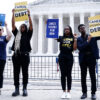Congressional Budget Office (CBO) Director Douglas Elmendorf recently testified before the Senate Budget Committee on policies that might give the economy a helpful lift in the near term. Congress is right to be concerned. But for an inventory surge last winter, the economy remains stuck in low gear at about 1 percent growth. This is too slow even to prevent unemployment from rising over time, let alone helping the ranks of the unemployed find new jobs.
As the muddling economy shows painfully clearly, what Congress has wrought so far—massive stimulus spending and deficits, badly designed tax cuts, repeated waves of new regulations, and now a threatened massive tax hike—has not helped and has almost certainly hurt. So CBO is a logical place among many for Congress to turn for guidance, but unfortunately what they received in return was a modern rendition of the old saying about the blind leading the blind.
The problem starts, as problems often do, with assumptions. CBO’s analysis relies on assumptions that, essentially, assume what they set out to prove. As Heritage budget expert Brian Riedl points out, logicians refer to this as the “begging-the-question fallacy.” CBO’s economic models assume that more government spending creates jobs and economic growth, and so modeling an increase in government spending projects—you guessed it—more jobs and stronger economic growth.
An old joke refers to an economist stranded on a desert island with nothing to eat but canned food. Rescued months later, he is asked how he survived. “I assumed a can opener,” he says. Outside the world of economist jokes, reality does not bend to our assumptions.
CBO’s flawed assumptions are based on the equally flawed theory of Keynesian economics, which assumes that aggregate demand can be increased by simply increasing government spending or “putting money in people’s pockets,” as President Bush was wont to say. If only the economy were that simple. The problem is when government deficit spending increases government then has to increase its borrowing from the private sector, thus reducing private spending. This is akin to filling a bucket at one end of a pool and then pouring it back in at the other. The net effect on the water level? Zero.
We’ve already seen how CBO’s assumptions favor Keynesian spending based on regularly updated scripts on the effectiveness of the stimulus bill. CBO says the stimulus created jobs. But as Riedl explains, “the CBO’s calculations are not based on actually observing the economy’s recent performance. Rather, they used an economic model that was programmed to assume that stimulus spending automatically creates jobs—thus guaranteeing their result.”
This approach to macroeconomics is what leads CBO to suggest that continuing unemployment benefits is the best form of stimulus. CBO argues that the unemployed tend to be most in need and therefore most likely to spend the money. It is no doubt true that recipients of unemployment checks spend the money. It is equally true that the money would have been spent in the private sector if government hadn’t borrowed it to finance the unemployment checks. CBO conveniently ignores this latter set of consequences.
Government spending and consumption-directed tax relief does not stimulate the economy. Reduction in government interference in the private sector—through reduced tax disincentives, reduced regulatory barriers, reduced trade barriers, reduced uncertainty about the nation’s fiscal course—would stimulate the economy. But these effective steps lie outside the CBO’s economic view.
If change does come to Congress in coming weeks, then change should come to the CBO, too. The American people will hold the Congress and the President accountable for our economy. Congress should hold its advisors equally accountable.
Co-authored by Kathryn Nix.



























